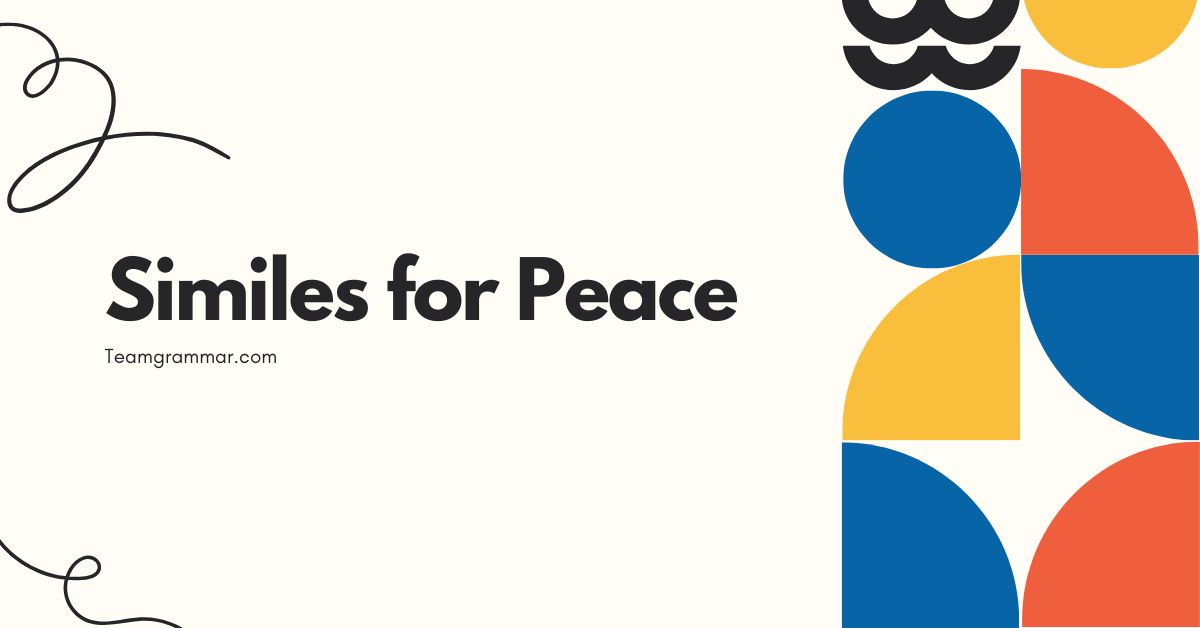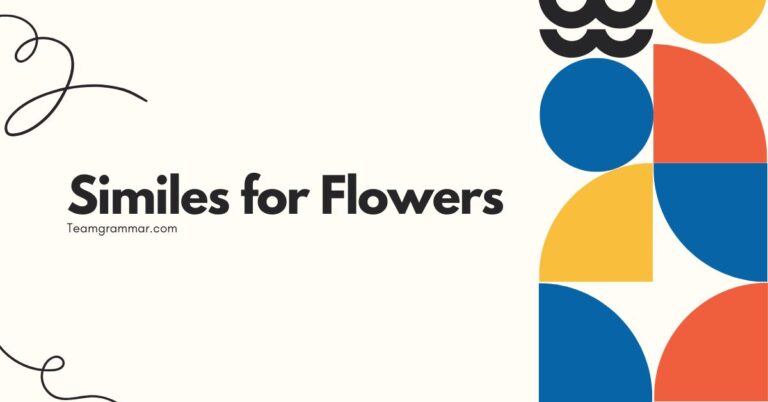37 Similes for Peace: Crafting Powerful Comparisons
Similes, a cornerstone of figurative language, enrich our communication by drawing parallels between seemingly disparate concepts. Understanding how to effectively use similes, particularly those centered around the theme of peace, allows us to convey complex emotions and ideas with greater nuance and impact.
This article delves into the world of similes for peace, exploring their structure, usage, and creative potential. Whether you’re a student, writer, or language enthusiast, this guide will equip you with the knowledge and skills to craft compelling comparisons that resonate with your audience.
Mastering similes not only enhances your writing but also deepens your appreciation for the art of language itself.
Similes play a crucial role in English grammar by adding depth and imagery to descriptions. This article benefits anyone looking to improve their writing, understand figurative language better, or explore the theme of peace through creative expression.
From beginners to advanced learners, the content is designed to be accessible and informative, providing a comprehensive understanding of similes for peace.
Table of Contents
- Definition of Similes for Peace
- Structural Breakdown of Similes
- Types of Similes
- Examples of Similes for Peace
- Usage Rules for Similes
- Common Mistakes with Similes
- Practice Exercises
- Advanced Topics in Similes
- Frequently Asked Questions
- Conclusion
Definition of Similes for Peace
A simile is a figure of speech that compares two unlike things using the words “like” or “as.” Its primary function is to create a vivid image or emphasize a particular quality by drawing a parallel between the subject and something else. Similes are a powerful tool for writers and speakers to make their language more engaging and descriptive.
In the context of “similes for peace,” we are specifically looking at comparisons that evoke feelings of tranquility, harmony, and the absence of conflict. These similes often involve imagery related to nature, serenity, and positive human interaction.
The goal is to use the comparison to enhance the reader’s or listener’s understanding and emotional connection to the concept of peace.
Similes are classified as a type of figurative language, falling under the broader category of comparisons. They function to add color and depth to writing, making it more memorable and impactful.
The context in which a simile is used can greatly affect its interpretation and effectiveness.
Structural Breakdown of Similes
The basic structure of a simile consists of three key elements: the subject, the connecting word (like or as), and the object of comparison. The subject is the thing being described, the connecting word establishes the comparison, and the object of comparison is the thing to which the subject is being likened.
The formula for a simile is:Subject + Connecting Word (like/as) + Object of Comparison. For example, in the simile “Peace is like a gentle breeze,” ‘peace’ is the subject, ‘like’ is the connecting word, and ‘a gentle breeze’ is the object of comparison.
This structure is fundamental to understanding and creating effective similes.
Variations in sentence structure can add complexity and nuance to similes. For instance, similes can be embedded within longer sentences or phrases.
The key is to maintain the clarity of the comparison, ensuring that the relationship between the subject and object of comparison is easily understood. The placement of the simile within a text can also influence its impact and emphasis.
Types of Similes
While all similes share the same basic structure, they can be categorized based on the type of comparison they make. Understanding these categories can help you choose the most appropriate simile for your specific purpose.
Descriptive Similes
Descriptive similes focus on highlighting specific qualities or characteristics of the subject. They aim to create a clear and vivid image in the reader’s mind by comparing the subject to something that shares similar attributes.
These similes are often used to enhance descriptions and make them more engaging.
Emotional Similes
Emotional similes are designed to evoke specific feelings or emotions in the reader. They compare the subject to something that is associated with a particular emotional response.
These similes are powerful tools for creating empathy and connecting with the audience on an emotional level.
Conceptual Similes
Conceptual similes compare abstract ideas or concepts to more concrete things. They help to make complex or difficult-to-understand ideas more accessible by relating them to something familiar and tangible.
These similes are often used in philosophical or theoretical writing.
Similes of Degree
Similes of degree emphasize the extent or intensity of a quality. They compare the subject to something that represents a similar quality but to a greater or lesser degree.
These similes are useful for highlighting the magnitude of a particular characteristic.
Examples of Similes for Peace
Here are some examples of similes for peace, categorized for clarity. These examples demonstrate the versatility and creative potential of similes in conveying the concept of peace.
Descriptive Similes for Peace
The following table provides examples of descriptive similes for peace, focusing on tangible qualities and characteristics associated with peace.
| Simile | Explanation |
|---|---|
| Peace is like a still lake on a windless day. | Describes the calmness and tranquility of peace. |
| Peace is as quiet as a sleeping child. | Emphasizes the serenity and gentleness of peace. |
| Peace is like a garden after a gentle rain. | Highlights the refreshing and revitalizing aspect of peace. |
| Peace is as soft as a dove’s feather. | Conveys the gentle and delicate nature of peace. |
| Peace is like the first light of dawn. | Represents the hope and new beginnings associated with peace. |
| Peace is as clear as a mountain stream. | Emphasizes the purity and clarity of peace. |
| Peace is like a warm blanket on a cold night. | Conveys the comfort and security of peace. |
| Peace is as smooth as polished glass. | Highlights the lack of friction and conflict in peace. |
| Peace is like a melody played on a harp. | Represents the harmony and beauty of peace. |
| Peace is as light as a dandelion seed floating in the wind. | Emphasizes the freedom and ease of peace. |
| Peace is like a deep breath after a long run. | Conveys the relief and relaxation of peace. |
| Peace is as vast as the open sky. | Highlights the boundless nature of peace. |
| Peace is like a sturdy oak tree, providing shelter and strength. | Represents the stability and resilience of peace. |
| Peace is as vibrant as a field of wildflowers. | Emphasizes the beauty and diversity of peace. |
| Peace is like a gentle snowfall covering the landscape. | Describes the serene and transformative effect of peace. |
| Peace is as calming as the sound of ocean waves. | Emphasizes the soothing and restorative nature of peace. |
| Peace is like a quiet library filled with wisdom. | Represents the knowledge and understanding that peace brings. |
| Peace is as refreshing as a cool drink on a hot day. | Highlights the revitalizing and satisfying aspect of peace. |
| Peace is like a shared meal among friends. | Conveys the connection and harmony found in peaceful interactions. |
| Peace is as grounding as bare feet on the earth. | Emphasizes the stability and centeredness that peace provides. |
| Peace is like a lighthouse guiding ships safely to shore. | Represents the guidance and direction that peace offers. |
| Peace is as comforting as a familiar lullaby. | Highlights the security and reassurance of peace. |
| Peace is like a tapestry woven with different cultures and beliefs. | Conveys the rich and inclusive nature of peace. |
| Peace is as strong as the bond between siblings. | Emphasizes the deep connection and loyalty found in peaceful relationships. |
| Peace is like a symphony of voices singing in harmony. | Represents the unity and cooperation of peace. |
| Peace is as essential as the air we breathe. | Highlights the fundamental importance of peace for human well-being. |
| Peace is like a bridge connecting different lands and people. | Conveys the connection and collaboration that peace fosters. |
| Peace is as precious as a rare and beautiful gem. | Emphasizes the value and desirability of peace. |
Emotional Similes for Peace
The following table provides examples of emotional similes for peace, focusing on the feelings and emotions associated with peace.
| Simile | Explanation |
|---|---|
| Peace feels like a warm embrace from a loved one. | Conveys the comfort and security of peace. |
| Peace is as joyful as children playing in a park. | Emphasizes the happiness and freedom of peace. |
| Peace feels like the relief after a long struggle. | Highlights the sense of resolution and completion that peace brings. |
| Peace is as calming as a mother’s gentle voice. | Conveys the soothing and reassuring nature of peace. |
| Peace feels like the satisfaction of a job well done. | Represents the sense of accomplishment and fulfillment associated with peace. |
| Peace is as hopeful as the first signs of spring. | Emphasizes the optimism and renewal that peace brings. |
| Peace feels like the warmth of the sun on your skin. | Conveys the comfort and invigoration of peace. |
| Peace is as comforting as a favorite childhood memory. | Highlights the nostalgia and security of peace. |
| Peace feels like the quiet contentment of a Sunday morning. | Represents the relaxation and tranquility of peace. |
| Peace is as uplifting as a soaring melody. | Emphasizes the joy and inspiration of peace. |
| Peace feels like the gentle hum of bees in a garden. | Conveys the harmony and balance of peace. |
| Peace is as reassuring as a familiar landmark. | Highlights the stability and guidance of peace. |
| Peace feels like the soft glow of candlelight. | Represents the warmth and serenity of peace. |
| Peace is as fulfilling as achieving a long-term goal. | Emphasizes the satisfaction and purpose of peace. |
| Peace feels like the quiet understanding between close friends. | Conveys the connection and empathy of peace. |
| Peace is as empowering as standing up for what you believe in. | Highlights the strength and conviction of peace. |
| Peace feels like the gentle sway of a hammock on a summer afternoon. | Represents the relaxation and ease of peace. |
| Peace is as grounding as the roots of an ancient tree. | Emphasizes the stability and resilience of peace. |
| Peace feels like the shared laughter of a family gathering. | Conveys the joy and connection of peace. |
| Peace is as liberating as the flight of a bird. | Highlights the freedom and ease of peace. |
| Peace feels like the comforting weight of a well-loved book. | Represents the knowledge and solace of peace. |
| Peace is as nurturing as the warmth of the sun on a flower. | Emphasizes the growth and support of peace. |
| Peace feels like the quiet admiration of a beautiful sunset. | Conveys the awe and gratitude of peace. |
| Peace is as invigorating as a walk in the forest. | Highlights the renewal and energy of peace. |
| Peace feels like the gentle rhythm of a heartbeat. | Represents the essential nature and vitality of peace. |
| Peace is as harmonious as a choir singing in unison. | Emphasizes the unity and cooperation of peace. |
| Peace feels like the security of a safe harbor. | Conveys the protection and stability of peace. |
| Peace is as precious as a heartfelt apology. | Highlights the value and healing power of peace. |
Conceptual Similes for Peace
The following table provides examples of conceptual similes for peace, focusing on abstract ideas and concepts related to peace.
| Simile | Explanation |
|---|---|
| Peace is like a bridge connecting divided communities. | Represents the unifying and connecting nature of peace. |
| Peace is as elusive as a butterfly, requiring patience and gentleness to capture. | Emphasizes the delicate and challenging nature of achieving peace. |
| Peace is like a seed that needs nurturing to grow into a strong tree. | Highlights the importance of cultivation and care in maintaining peace. |
| Peace is as fragile as a glass sculpture, easily shattered by violence. | Conveys the vulnerability and preciousness of peace. |
| Peace is like a puzzle where every piece, representing different cultures and perspectives, must fit together. | Represents the inclusivity and cooperation required for peace. |
| Peace is as complex as a spiderweb, with interconnected threads of understanding and empathy. | Emphasizes the intricate and interdependent nature of peace. |
| Peace is like a symphony, where different voices and instruments come together in harmony. | Represents the unity and collaboration of peace. |
| Peace is as vital as the air we breathe, essential for the survival and well-being of humanity. | Highlights the fundamental importance of peace for human existence. |
| Peace is like a tapestry woven with threads of justice, equality, and compassion. | Represents the diverse and interconnected elements of peace. |
| Peace is as transformative as the butterfly emerging from its chrysalis. | Emphasizes the growth and change that peace brings. |
| Peace is like a lighthouse guiding ships through stormy seas. | Represents the guidance and direction that peace offers. |
| Peace is as resilient as a bamboo tree, bending but not breaking in the face of adversity. | Highlights the strength and adaptability of peace. |
| Peace is like a wellspring of hope, providing renewal and inspiration for future generations. | Represents the enduring and life-giving nature of peace. |
| Peace is as inclusive as a circle, embracing all people regardless of their background. | Emphasizes the universality and acceptance of peace. |
| Peace is like a compass guiding us toward a more just and equitable world. | Conveys the direction and purpose of peace. |
| Peace is as essential as the roots of a tree, providing stability and nourishment for growth. | Highlights the foundational importance of peace. |
| Peace is like a conversation, requiring active listening and mutual respect. | Represents the communication and understanding needed for peace. |
| Peace is as precious as a rare and beautiful flower, requiring careful cultivation and protection. | Emphasizes the value and fragility of peace. |
| Peace is like a shared dream, requiring collective effort and vision to realize. | Conveys the collaboration and aspiration of peace. |
| Peace is as transformative as the dawn, bringing new light and possibilities. | Highlights the renewal and hope of peace. |
| Peace is like a puzzle where every piece, representing different cultures and perspectives, must fit together. | Represents the inclusivity and cooperation required for peace. |
| Peace is as complex as a spiderweb, with interconnected threads of understanding and empathy. | Emphasizes the intricate and interdependent nature of peace. |
| Peace is like a symphony, where different voices and instruments come together in harmony. | Represents the unity and collaboration of peace. |
| Peace is as vital as the air we breathe, essential for the survival and well-being of humanity. | Highlights the fundamental importance of peace for human existence. |
| Peace is like a tapestry woven with threads of justice, equality, and compassion. | Represents the diverse and interconnected elements of peace. |
| Peace is as transformative as the butterfly emerging from its chrysalis. | Emphasizes the growth and change that peace brings. |
| Peace is like a lighthouse guiding ships through stormy seas. | Represents the guidance and direction that peace offers. |
| Peace is as resilient as a bamboo tree, bending but not breaking in the face of adversity. | Highlights the strength and adaptability of peace. |
Usage Rules for Similes
When using similes, it’s important to ensure that the comparison is clear, relevant, and effective. The strength of a simile lies in its ability to create a vivid and meaningful connection between two seemingly different things.
Clarity: The comparison should be easily understood by the reader or listener. Avoid obscure or overly complex references that may confuse the audience.
Relevance: The object of comparison should share a significant characteristic or quality with the subject. The comparison should highlight a specific aspect of the subject that you want to emphasize.
Originality: While common similes can be effective, strive for originality to make your writing more engaging and memorable. Avoid clichés and try to come up with fresh and creative comparisons.
Context: Consider the context in which the simile is being used. The appropriateness of a simile can depend on the tone, audience, and purpose of the writing or speech.
Common Mistakes with Similes
Several common mistakes can weaken or invalidate similes. Being aware of these pitfalls can help you craft more effective comparisons.
Using clichés: Overused similes like “as busy as a bee” or “as quiet as a mouse” lack originality and can make your writing seem uninspired.
Illogical comparisons: The comparison should make sense and be based on a shared characteristic. For example, “Peace is like a rock” is not as effective as “Peace is like a calm ocean,” because the former doesn’t highlight a positive attribute typically associated with peace.
Mixing metaphors and similes:While both are figures of speech, they function differently. A simile uses “like” or “as” to compare, while a metaphor states that one thing *is* another.
Avoid blending the two in a confusing way.
Incorrect:The world is like a stage. (Simile)
The world is a stage like a play.
(Incorrect – mixing simile and metaphor)
Correct: The world is a stage. (Metaphor)
Overusing similes: Too many similes in a short space can make your writing seem cluttered and distracting. Use similes sparingly and strategically to maximize their impact.
Practice Exercises
These exercises will help you practice identifying and creating effective similes for peace.
Exercise 1: Identifying Similes
Identify the similes in the following sentences.
| Question | Answer |
|---|---|
| 1. The diplomat’s words were as soothing as a balm. | as soothing as a balm |
| 2. Peace is a distant dream. | (No simile – this is a metaphor) |
| 3. The treaty was like a fragile truce. | like a fragile truce |
| 4. Their unity stood strong. | (No simile) |
| 5. Hope is as bright as the morning sun. | as bright as the morning sun |
| 6. The negotiation process felt like climbing a mountain. | like climbing a mountain |
| 7. Peace is as precious as a child’s laughter. | as precious as a child’s laughter |
| 8. The agreement was a beacon of hope. | (No simile – this is a metaphor) |
| 9. The atmosphere was as tense as a drawn bow. | as tense as a drawn bow |
| 10. Forgiveness is like a key to unlock a prison. | like a key to unlock a prison |
Exercise 2: Completing Similes
Complete the following similes with an appropriate object of comparison.
| Question | Answer |
|---|---|
| 1. Peace is like __________. | a gentle rain |
| 2. Forgiveness is as powerful as __________. | a rushing river |
| 3. Unity is like __________. | a strong bridge |
| 4. Hope is as bright as __________. | a star in the night |
| 5. Reconciliation is like __________. | planting a seed |
| 6. Diplomacy is as delicate as __________. | a butterfly’s wing |
| 7. Understanding is like __________. | a clear mirror |
| 8. Compassion is as warm as __________. | the morning sun |
| 9. Justice is like __________. | a balanced scale |
| 10. Harmony is as sweet as __________. | a songbird’s melody |
Exercise 3: Creating Similes
Create your own similes for peace using the following subjects.
| Subject | Possible Simile |
|---|---|
| 1. Peace | Peace is like a quiet garden, free from weeds and thorns. |
| 2. Forgiveness | Forgiveness is as liberating as releasing a caged bird. |
| 3. Unity | Unity is like a tightly woven rope, strong and unbreakable. |
| 4. Hope | Hope is as persistent as a flower pushing through concrete. |
| 5. Reconciliation | Reconciliation is like mending a broken fence, restoring connection. |
| 6. Diplomacy | Diplomacy is as careful as a surgeon’s hand, precise and deliberate. |
| 7. Understanding | Understanding is like a clear lens, allowing us to see things as they are. |
| 8. Compassion | Compassion is as comforting as a warm blanket on a cold day. |
| 9. Justice | Justice is like a guiding star, leading us towards fairness. |
| 10. Harmony | Harmony is as beautiful as a rainbow after a storm. |
Advanced Topics in Similes
For advanced learners, exploring the nuances of similes can lead to more sophisticated and impactful writing. This includes understanding how similes interact with other figures of speech and how they can be used to create complex layers of meaning.
Extended Similes: An extended simile is a simile that is developed over several lines or even an entire paragraph. This allows for a more detailed and nuanced comparison, creating a richer and more immersive experience for the reader.
Similes and Metaphors in Combination: Combining similes and metaphors can create powerful imagery and deeper meaning. For example, a writer might start with a simile to introduce a concept and then transition to a metaphor to solidify the comparison.
Cultural Context:The effectiveness of a simile can depend on the cultural background of the audience. A simile that resonates with one culture may not have the same impact on another.
Understanding cultural nuances is essential for effective communication.
Frequently Asked Questions
Here are some frequently asked questions about similes, with detailed answers to help clarify any confusion.
- What is the difference between a simile and a metaphor?
A simile is a comparison using “like” or “as,” while a metaphor states that one thing *is* another. For example, “He is like a lion” (simile) versus “He is a lion” (metaphor). The key difference is the explicit comparison in a simile versus the implied comparison in a metaphor.
- Can a simile be a cliché?
Yes, a simile can be a cliché if it is overused and lacks originality. Clichés lose their impact because they have become too familiar. Strive for fresh and creative comparisons to avoid clichés.
- How can I make my similes more effective?
To make your similes more effective, focus on clarity, relevance, and originality. Choose comparisons that are easily understood, highlight meaningful similarities, and avoid overused phrases. Consider the context and audience to ensure the simile resonates with your intended readers or listeners.
- Is it okay to use multiple similes in one piece of writing?
Yes, it is okay to use multiple similes, but use them sparingly. Too many similes can make your writing seem cluttered and distracting. Use them strategically to emphasize key points and create vivid imagery.
- What are some common mistakes to avoid when using similes?
Common mistakes include using clichés, making illogical comparisons, mixing metaphors and similes, and overusing similes. Being aware of these pitfalls can help you craft more effective and impactful comparisons.
- How important is the context when using a simile?
Context is very important. The appropriateness and effectiveness of a simile can depend on the tone, audience, and purpose of the writing or speech. Consider the cultural background of your audience, as well, for maximum impact.
- Can similes be used in formal writing?
Yes, similes can be used in formal writing, but they should be used judiciously. In formal writing, clarity and precision are paramount. Ensure that the simile enhances understanding and does not detract from the overall tone.
- How do I choose the right object of comparison for my simile?
Choose an object of comparison that shares a significant characteristic or quality with the subject you are describing. The comparison should highlight a specific aspect of the subject that you want to emphasize. Consider what image or feeling you want to evoke in the reader or listener.
- Are similes only for descriptive writing?
No, similes are not only for descriptive writing. While they are often used to enhance descriptions, they can also be used to explain complex ideas, evoke emotions, and create connections between seemingly disparate concepts.
- How can I practice using similes effectively?
Practice by identifying similes in the writing of others, completing unfinished similes, and creating your own similes using different subjects. Pay attention to the impact of your similes and seek feedback from others to improve your skills.
Conclusion
Mastering similes, particularly those related to peace, empowers you to express complex ideas and emotions with greater clarity and impact. By understanding their structure, types, and usage rules, you can craft compelling comparisons that resonate with your audience.
Avoid common mistakes, practice regularly, and explore advanced techniques to elevate your writing to new heights.
Similes are a valuable tool for writers and speakers alike, enabling them to paint vivid pictures with words and create meaningful connections with their audience. By embracing the art of comparison, you can enrich your communication and contribute to a more peaceful and understanding world.
Remember to focus on clarity, relevance, and originality to create similes that are both effective and memorable.







